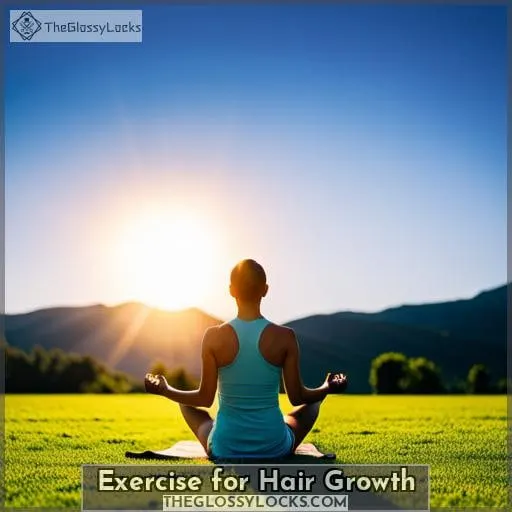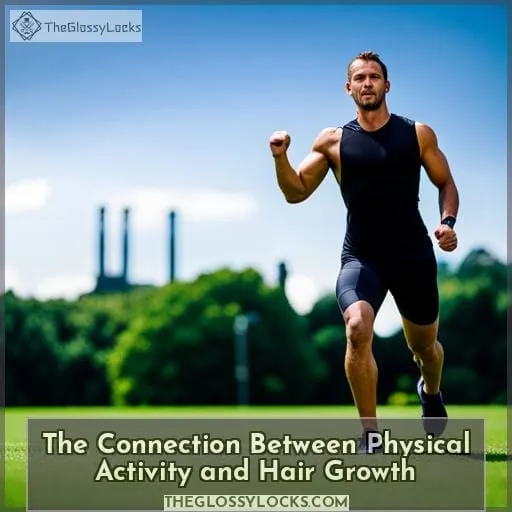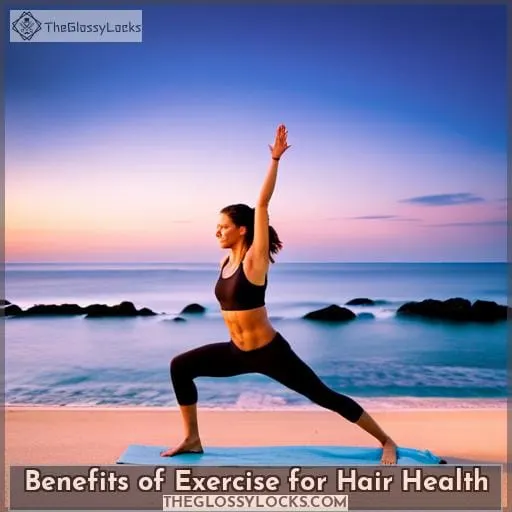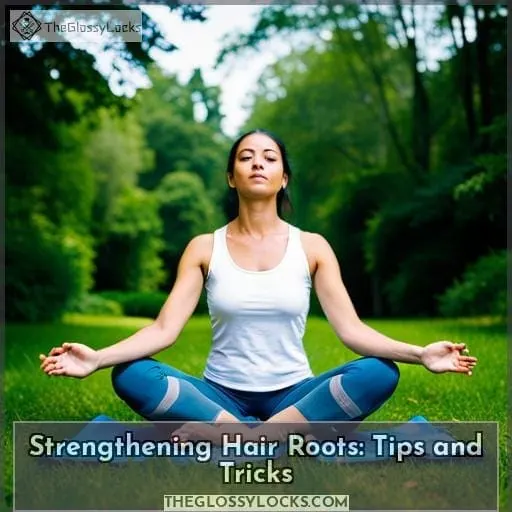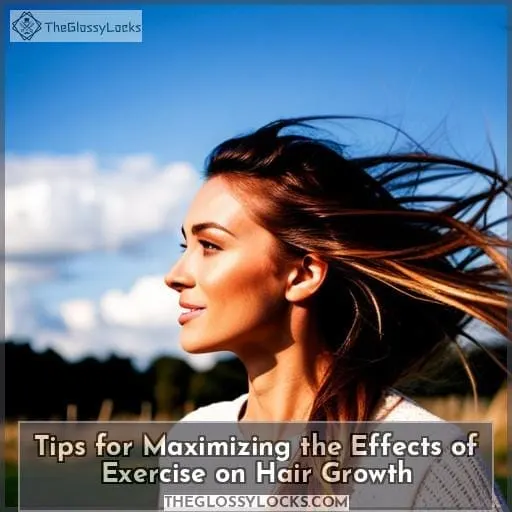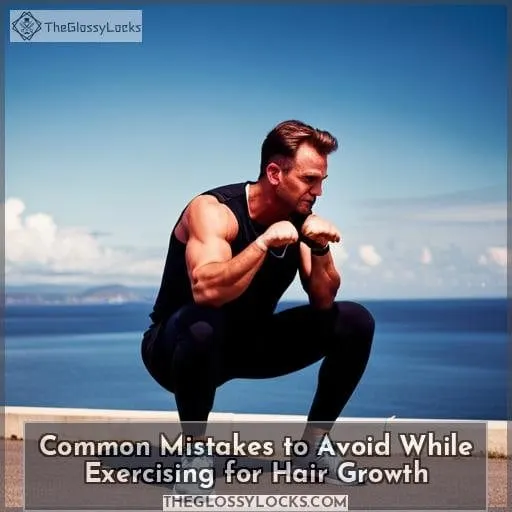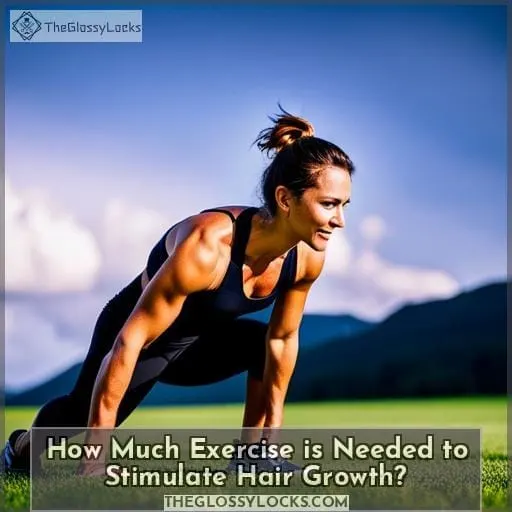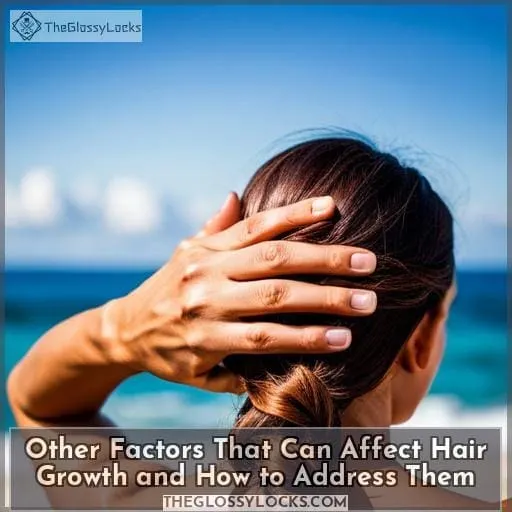This site is supported by our readers. We may earn a commission, at no cost to you, if you purchase through links.
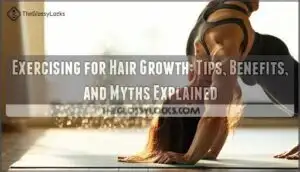
Table Of Contents
- Key Takeaways
- The Connection Between Physical Activity and Hair Growth
- Understanding the Causes of Hair Loss
- Benefits of Exercise for Hair Health
- Strengthening Hair Roots: Tips and Tricks
- Natural Remedies to Promote Hair Growth
- Tips for Maximizing the Effects of Exercise on Hair Growth
- Common Mistakes to Avoid While Exercising for Hair Growth
- Debunking Myths About Exercise and Hair Health
- How Much Exercise is Needed to Stimulate Hair Growth?
- Other Factors That Can Affect Hair Growth and How to Address Them
- Frequently Asked Questions (FAQs)
- What hair loss conditions can exercise help with?
- How often should I exercise for hair health?
- Are there any specific exercises that are beneficial for hair growth?
- Are there any risks associated with exercising for hair growth?
- How long does it take for exercise to start having an effect on hair growth?
- Conclusion
Key Takeaways
- Regular moderate-to-high intensity exercise can combat hair loss and promote hair growth by stimulating blood flow and promoting healthy follicles.
- Excessive physical activity can temporarily disrupt the hair growth cycle, so it’s important to exercise in a balanced way.
- Androgenetic alopecia, a common form of hair loss caused by genetics and non-genetic factors, can be helped by regular moderate-to-high intensity exercise.
- It typically takes several months of regular exercise to start seeing an effect on hair growth, so consistency is key.
The Connection Between Physical Activity and Hair Growth
The connection between physical activity and hair growth is important to note. Research has shown that 45.2% of healthy individuals had alopecia, with the total amount of exercise being larger in this group than those without it.
This could be due to several factors, such as hormonal changes or oxidative stress caused by exercising, both of which can potentially affect hair follicles and blood circulation, which are necessary for proper growth.
Nutrition also plays an important role in stimulating hair health. Consuming foods rich in iron, omega-3 fatty acids, and ginseng supplements can help improve scalp condition and reduce shedding significantly over time when combined with regular exercise habits like jogging or strength training workouts that get your heart rate up while helping relieve anxiety-associated symptoms of stress-related baldness, which have been linked to female pattern baldness (an inherited form).
Scalp massage techniques can boost blood flow around the area, thereby improving overall results. Using nourishing masks containing aminoMar C, mollusc powder, Vitamin C, organic silica, etc.
Understanding the Causes of Hair Loss
Hair loss can have many causes, ranging from genetic factors to medical conditions, hormonal changes, medications, stress, or chemical treatments. It is crucial to comprehend the underlying cause of hair loss to take steps towards regrowing it.
Genetic predisposition may be a factor for some individuals, while others may experience hair loss due to medical conditions or hormonal fluctuations caused by medication. Additionally, external stressors such as strong chemical treatments used on the hair can also contribute significantly.
Genetic Factors
You may be wondering if genetics play a role in hair loss and growth. Genetic inheritance can cause hormone balance problems, leading to hair fall or even baldness. A family history of AGA (Androgenetic Alopecia) can also increase the risk of developing it due to genetic factors.
Non-genetic factors such as oxidative stress and the ROS hypothesis are also important contributors to this condition. Regular moderate-to-high intensity exercise helps increase blood flow, which has been found beneficial for reducing hair loss by stimulating the follicles but not causing hormonal imbalance that could lead to baldness later on.
Medical Conditions or Hormonal Changes
Hormonal changes, medical conditions, and genetics can all affect your hair growth or loss. Hair health is highly dependent on hormone balance, stress management, and medication effects. Dietary changes and lifestyle modifications are also necessary to maintain healthy hair.
Testosterone levels increase during exercise, which may cause the occurrence of alopecia if not managed properly with other medical conditions taken into account. To maximize hair health, awareness is key in order to prevent any further damage from occurring.
Medications
It is important to be mindful of any medications you may be taking, as they can have an effect on your hair health. Taking breaks from medications and ensuring proper nutrition are essential for healthy locks.
Identifying the cause of hair loss is key in creating a plan with natural remedies such as vitamin D, vitamin E, aloe vera, and Adho Mukha Svanasana exercises combined with regular scalp massage.
Stress
Stress can be a major cause of hair loss, sapping life from your locks like air from a deflated balloon. Techniques for managing stress, such as changes in diet and meditation, are beneficial ways to reduce stress levels.
Natural remedies for hair care, such as reactive oxygen species and left nostril breathing, release endorphins that help reduce anxiety.
Chemical Treatments
Chemical treatments, such as styling or coloring your hair, can lead to breakage and hair loss. To protect against this, try using natural products like essential oils and avoiding harsh chemical products.
Scalp massage with nourishing oils will help stimulate the scalp for healthier hair growth. High-intensity interval training mixes cardio and strength training to boost blood flow in the body, which can also benefit hair health.
Avoid blow dryers, which can damage delicate strands of hair over time. Instead, opt for patting your mane gently with a towel after washing it.
Benefits of Exercise for Hair Health
By engaging in activities that get your heart rate up, you can help nourish and invigorate hair follicles – just like watering a garden to help it grow. Regular moderate-to-high intensity exercise has been linked to a protective effect against oxidative stress, which is believed to play an important role in the occurrence of alopecia.
Avoiding heat damage through excessive styling or chemical treatments, as well as consuming adequate amounts of vitamins and proteins, can also be beneficial for hair health.
The total amount and intensity of exercise have both been shown to positively influence AGA patients; however, the ROS hypothesis may explain why some people benefit more than others.
Best yoga poses, such as Pranayama exercises involving breath work, along with Wind Relieving Pose, Camel Pose, and Strength Training workouts, are all great ways to not only reduce existing hair fall but also encourage new growth over time while helping release built-up tension around neck muscles at the same time!
Strengthening Hair Roots: Tips and Tricks
If you’re looking to strengthen your hair roots, there are a few tips and tricks you should try. Minimizing heat damage, boosting vitamin intake, choosing the right shampoo, incorporating protein into your diet, and trying a nourishing hair mask can all help ensure that your strands stay strong.
Minimizing Heat Damage
To keep your hair looking its best, avoid using heating tools and chemical products whenever possible. Instead, opt for scalp massages to stimulate the natural hair growth cycle and oxygen supply. Hair styling can also be done with heat-proofing products such as Bu Young Choi or a nourishing hair mask to increase the strength of follicles without damaging them.
Boosting Vitamin Intake
Boosting your vitamin intake can help promote healthy hair growth. To achieve this, consume foods that are rich in vitamins and minerals, such as dark green leafy vegetables, figs, jaggery, and dates. Additionally, get a scalp massage to stimulate the follicles, practice yoga poses for hormonal balance, perform strength training workouts to increase blood flow, and reduce oxidative stress with moderate-to-high intensity exercise.
It is also important to address any nutritional deficiencies by taking supplements like AminoMar C or ginseng tablets if necessary.
Choosing the Right Shampoo
Choosing the right shampoo is key to keeping your hair healthy and strong. Pick wisely, or you may end up in a slippery slope! Opt for sulfate-free products to avoid stripping away natural oils from the scalp during frequent shampooing.
Regular use of hydrating conditioners can nourish strands. Additionally, natural oils like coconut and argan oil can help restore moisture levels on the scalp and provide protection against heat damage caused by styling tools.
Results of a study show that regular exercise can help reduce the proportion of alopecia patients. Possible explanations include changes in hormone levels or oxidative stress generated during physical activity, which induces a protective effect against alopecia.
Choose your hair care routine carefully, and healthier locks await you!
Incorporating Protein Into Your Diet
Including protein in your diet is a great way to support strong and healthy hair growth. Eating foods rich in nourishment, such as dark green leafy vegetables, fish, walnuts, and chia seeds, can help keep the scalp hydrated and promote new hair follicles.
To prevent heat damage from blow dryers or flat irons, make sure to use the right shampoo for your hair type and apply a nourishing mask once a week.
Trying a Nourishing Hair Mask
Treat yourself to a nourishing hair mask for healthier, shinier locks! Combine it with a healthy diet, stress management techniques like pranayama breathing and neck exercises, as well as chemical-free styling.
Avoid using blow dryers and other heat tools that can damage your hair. Massage your scalp regularly to promote hair regrowth and use products that support healthy growth.
Natural Remedies to Promote Hair Growth
You may be looking for natural remedies to promote hair growth and achieve a healthier, fuller head of hair. Aloe Vera is known to help with scalp health and can contribute to healthy hair growth when used as a topical treatment.
Coconut oil has been shown in studies to improve the strength of damaged strands while also helping retain moisture in the follicles, which promotes faster-growing locks. Dermatologists often recommend Viviscal, ginseng, and other herbal supplements because they have been proven effective at nourishing both scalps and hair from within for longer-term results.
Aloe Vera
Try adding aloe vera to your hair care routine – it’s a real ‘miracle-worker’ when it comes to promoting healthy, strong locks! Aloe Vera is packed with vitamins and minerals, which can boost hair nutrition.
To get the most out of Aloe Vera, use it in combination with regular scalp massages and stress management techniques. Include an exercise regimen into your daily or weekly routines, as this will increase blood flow throughout the body and improve oxygen levels on the scalp for enhanced hair growth.
Coconut Oil
Adding coconut oil to your hair care routine is a great way to nourish and protect your locks. It’s an excellent source of healthy fats, vitamins, and antioxidants that can help prevent baldness and reduce hair loss.
Benefits of using coconut oil on your hair include restoring moisture balance in the scalp, providing nutrition for strong roots, acting as a natural heat protector against blow dryers and other hot styling tools, promoting circulation through scalp massage while exercising or doing HIIT workouts, and helping with split ends repair due to its anti-inflammatory properties.
Coconut oil is one of the best oils you can use for healthier looking locks!
Viviscal
Experience fuller, thicker hair with Viviscal! AminoMar promotes healthy hair growth and strength, while regular high-intensity exercise enhances blood flow to the scalp. The wind-relieving pose aids in bowel movement, pranayama stimulates scalp pores, and a weekly scalp massage can enhance results.
Ginseng
Ginseng supplements can help promote hair growth and stimulate hair follicles, making them stronger. Taking a daily dose of ginseng helps maintain a healthy scalp and encourages new growth. Scalp massage with AminoMar C, mollusc powder, or organic silica also helps nourish the scalp.
Pranayama breathing techniques like alternate nostril breathing or wind relieving pose increase blood flow to the head area, promoting better circulation for thicker locks. Short HIIT workouts are another way to improve blood flow throughout your body, which is essential for thickening thinning strands.
Tips for Maximizing the Effects of Exercise on Hair Growth
You can maximize the effects of exercise on hair growth by following certain tips. Rubbing all your fingernails together stimulates brain activity and revives dormant follicles. This simple action has been found in studies to have a success rate of up to 25%.
Regular moderate-to-high intensity exercises help induce a protective effect against oxidative stress while also transiently increasing testosterone levels. Practicing neck exercises, scalp massages, and wind relieving poses are beneficial for reducing stress that may cause hair fall.
A nourishing hair mask is essential for stimulating healthy growth of new hairs and making existing ones stronger. High Intensity Interval Training (HIIT) helps get your heart rate up without being too aggressive, while Standing Fold Pose revitalizes blood cells through improved circulation in the body’s extremities like feet or head, which includes our scalp! Finally, large-scale studies suggest a significant association between regular physical activity and the most common type of hair loss – Androgenetic Alopecia (AGA).
Common Mistakes to Avoid While Exercising for Hair Growth
If you’re looking to maximize the benefits of exercise on hair growth, be sure to avoid these common mistakes. Regular exercise is important for optimal hair health, but too much or overly intense workouts can cause more harm than good.
High-intensity workouts and neck exercises should also be kept in moderation as they can lead to excessive stress, which may result in further hair loss.
It’s essential that you use a nourishing scalp massage oil or mask regularly after exercising, as environmental factors such as cold weather and dry air could damage your scalp. An observational study suggests that the frequency of low-intensity exercise was higher among those with alopecia compared with those without.
However, this doesn’t mean more intensive exercises are better supported when trying to improve hair growth. Rather, there needs to be a balance between both types of physical activity for the best results.
Moreover, different individuals have varying levels of tolerance towards specific forms and intensities of workout routines. So, it is always advisable not only to monitor how effective certain activities are at improving your overall fitness level but also to keep track of any changes related to your daily habits regarding dieting and sleeping patterns.
These might influence one’s response positively or negatively while doing regular physical activities focused primarily on enhancing general well-being conditions, including healthy hair.
Debunking Myths About Exercise and Hair Health
You may have heard a lot of myths about exercise and hair health, but the truth is that exercising can actually benefit your hair. The most common questions are: Does exercise cause hair loss? Can exercise make hair thicker? And can rubbing nails promote hair growth? To debunk these myths, let’s take an in-depth look at how physical activity affects our hair.
Does Exercise Cause Hair Loss?
Although excessive physical activity can temporarily disrupt the hair growth cycle, exercising in a balanced way is essential for healthy hair. Genetics and hormonal changes are some of the factors that can cause hair loss. Stress management through exercise is an easy yet effective technique to reduce this health issue.
A survey-based study showed a significant difference in terms of the amount of exercise among normal and AGA groups; however, no causal link was found between physical activity and alopecia severity. To ensure optimal results from your current state of exercise, it’s important to consider its possible influence on your overall well-being, including reducing risks related to baldness or thinning out issues caused by inadequate stimulation.
To achieve this, you can follow these tips:
- Moderate intensity workouts will help improve blood circulation throughout the scalp region.
- Pranayama breathing exercises will reduce stress levels.
- Strength training helps stimulate hormones.
- Neck stretches keep muscles relaxed.
- Hair masks nourish follicles and promote new strand growth.
Exercise not only offers many benefits but also assists with managing potential negative influences like preventing high testosterone levels, which may occur due to intense activities.
Can Exercise Make Hair Thicker?
Exercising regularly can help you achieve luscious, thicker locks over time. Proper protein and vitamin intake are essential for hair health, as well as avoiding heat damage or hair styling treatments that use chemical products.
For a nourishing boost to your tresses, consider adding in a natural mask containing aloe vera or other active ingredients.
A further study is needed to confirm the possible explanation behind this increasing trend of exercise making our locks thicker and healthier. However, those who love high-energy exercises can enjoy the benefits from it! Pranayama breathing techniques, focusing on placing one finger on your left nostril while pressing down to breathe through the right nostril, may even make hair more lustrous over time when paired with strength training workouts that get your heart rate up and blood flowing throughout the body.
Can Rubbing Nails Promote Hair Growth?
You may be surprised to learn that rubbing your fingernails together regularly can promote hair growth! This simple exercise is said to have many benefits, such as:
- Preventing shedding by stimulating and strengthening the scalp.
- Increasing hydration levels in the scalp for optimal hair health.
- Reducing risks of damaging styling treatments and chemical products.
- Balancing hormones for healthy functioning of natural oils in hair follicles.
- Enhancing exercise frequency with a similar tendency among normal patients as well as those with alopecia.
This activity also has an active component that provides further functional results when it comes to great poses like neck exercises and headstands or inverted positions that aid lustrous growth of hair due to its revitalizing effect on blood cells.
How Much Exercise is Needed to Stimulate Hair Growth?
It’s essential to find the right balance of exercise for hair health – but how much is enough? Studies have shown that moderate-to-high intensity exercises can help protect against oxidative stress, which plays a role in hair loss.
However, there is no significant difference between low and high levels of physical activity when it comes to stimulating growth.
According to Hind M Almohanna, MD, regular exercise may be beneficial for maintaining healthy hair follicles as well as promoting overall wellness. A vegan diet with nutrient-rich foods like dark green leafy vegetables, ginseng supplements, and omega-3 fatty acids will also provide an important boost in nourishment for your scalp.
In addition, oil treatments and scalp massages are great ways to improve blood circulation in the head area while relieving stress-related tension around neck muscles or blocked follicles due to sweat accumulation during workouts.
Finally, incorporating yoga poses such as standing fold pose or camel pose into your routine could stimulate new cell regeneration and strengthen existing ones, leading you closer towards achieving long-lasting results from exercising regularly for healthier-looking hair.
Other Factors That Can Affect Hair Growth and How to Address Them
With the right combination of diet and lifestyle choices, you can make a positive impact on your hair growth. Scalp massage is one way to stimulate blood flow to the scalp, which can help with hair growth.
Pranayama, or the wind relieving pose, is also known for promoting healthy digestion, which in turn helps promote healthier follicles and stronger strands of hair.
High-intensity interval training (HIIT) mixes cardio exercises with strength training, increasing circulation throughout your body, including your scalp. This helps nourish dormant follicles back into action! The standing fold pose relaxes tension built up from stress by calming both mind and body, reducing cortisol levels to encourage less shedding due to oxidative stress associated with exercise-induced damage.
Incorporating regular workouts, such as yoga poses or even simple neck stretches, will release pent-up tensions around muscles, allowing more nutrients access towards encouraging new strand formation while strengthening existing ones!
Frequently Asked Questions (FAQs)
What hair loss conditions can exercise help with?
Exercise can help with androgenetic alopecia, a common form of hair loss caused by genetics and non-genetic factors. Regular moderate to high-intensity exercise can reduce oxidative stress, which may in turn reduce the severity of hair loss.
It is important to have an intimate understanding of the condition for successful management, so speaking to your doctor is highly recommended.
How often should I exercise for hair health?
Exercise regularly for optimal hair health! Aim to work out at least three times a week and vary your intensity levels. Be sure to include aerobic activities like jogging or yoga, as well as strength training exercises.
Are there any specific exercises that are beneficial for hair growth?
Engaging in specific exercises can aid in promoting hair growth. Consider incorporating activities such as jogging, pranayama breathing, high-intensity interval training, and strength workouts into your routine.
Additionally, massaging your scalp can stimulate growth, and inverted poses like headstands can enhance hair luster. To nourish your hair, use a mask that boosts its health and consider adding supplements like ginseng and AminoMar C to your diet.
Are there any risks associated with exercising for hair growth?
Exercising for hair growth can be beneficial, but there are potential risks associated with it. Overexertion could lead to temporary hair loss by disrupting the natural growth cycle of your follicles. Additionally, sweat and salt buildup on the scalp from exercising can also damage your hair.
How long does it take for exercise to start having an effect on hair growth?
It typically takes several months of regular exercise to start seeing an effect on hair growth. Exercise stimulates blood flow, which promotes healthy follicles and can help reduce hair loss. Additionally, exercise helps reduce stress levels that can contribute to further hair loss.
Conclusion
Exercising can be beneficial for your hair growth and health, but it’s important to do it in a balanced way. Moderation is key to getting the most out of your workout. Remember to keep your scalp hydrated, use a nourishing hair mask, and stay away from tight hairstyles and heat styling tools.
With the right hair care routine and exercise habits, you can have a head full of healthy, strong, and vibrant hair.

